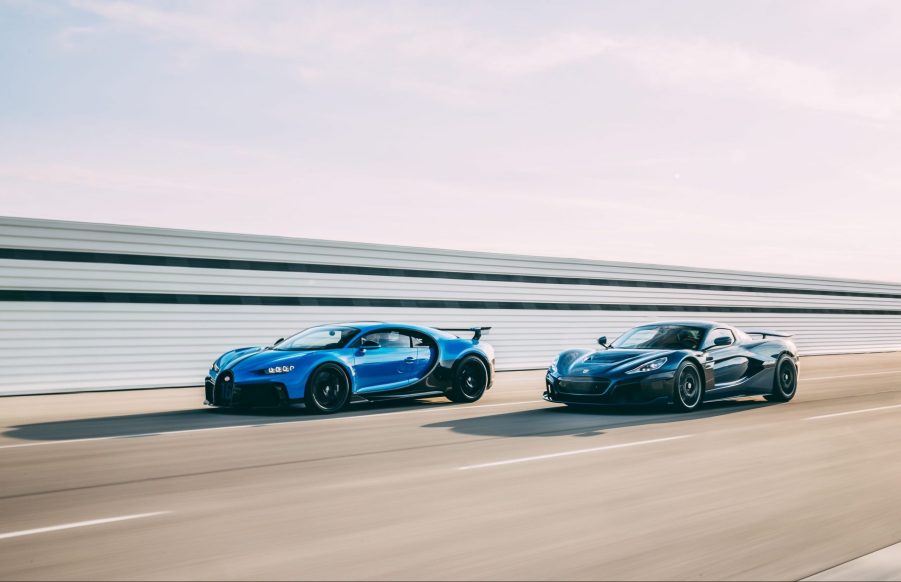
Bugatti Officially Merges With Electric Supercar Brand Rimac
Up until now, Bugatti has been one of several premium brands in the Volkswagen family. And that’s been the case since VW resurrected Bugatti in 2009. However, over the last few months reports claimed that the hypercar brand could be up for sale. And as of today, it’s official: Bugatti is joining forces with electric supercar company Rimac.
Bugatti and Rimac combine with Porsche’s help to make Bugatti-Rimac

Given that Bugatti recently had one of its best quarters ever, the notion that Rimac now owns it might seem surprising. However, the truth is that Rimac doesn’t own Bugatti; instead, the two have merged to form Bugatti-Rimac. Also, the Volkswagen Group still has a stake in this joint venture through Porsche.
Some background should help dispel the potential confusion. A few years ago, Volkswagen approached Rimac to supply parts for a hybridized Chiron, Car and Driver explains. Rimac, though, proposed making a brand-new hybrid hypercar with a less expensive naturally-aspirated engine. Rather than pay Rimac to build and design such a car, the VW Group proposed merging the two brands. And now, that merger has been finalized.
As for how Porsche enters into the Bugatti-Rimac equation, the truth is that Volkswagen technically didn’t own Bugatti directly. Instead, it owns another brand, Porsche, that owned Bugatti. This is like how Volkswagen owns Audi which owns Lamborghini; VW thus technically owns Lamborghini but doesn’t directly control it.
In the case of the newly-formed Bugatti-Rimac, Rimac directly owns 55% of Bugatti. Porsche, though, controls the remaining 45%, and also owns 24% of Rimac. And moving forward, it “will play ‘a strong role’ in the JV as a strategic partner as Bugatti and Rimac learn from one another,” Roadshow reports. Mate Rimac, though, will remain as CEO.
Does this mean there will be an electric Bugatti supercar or hypercar?

The Bugatti-Rimac JV won’t be official until Q4 2021, so the brands have some time to work on their strategy. And rest assured, the electric Nevera supercar is still going ahead, as is the Chiron. Still, it’s reasonable to expect some kind of high-performance EVs from the JV.
Speaking with Top Gear, Mate Rimac confirmed there will be fully electric Bugatti models in the future. However, the CEO also confirmed that Bugatti won’t abandon internal combustion quite yet. Before the end of the decade, and coming full-circle to what kicked this all off, the JV plans to release a hybrid Bugatti.
That being said, while this is a joint venture, the two brands will stay relatively separate. Bugattis won’t be rebadged Rimacs and vice versa. And while the JV’s headquarters will be Rimac’s new campus in Croatia, the Bugatti ‘factory’ in Molsheim, France isn’t closing.
The new joint venture will make more than just cars
There’s one more bit of news regarding the merger, though. Rimac doesn’t just make electric supercars: it also tests and develops EV and hybrid tech as an automotive supplier. And it will still do that under this new JV—kind of.
Before the merger, Rimac’s full name was ‘Rimac Automobili.’ Now, that parent company will be known as ‘Rimac Group.’ And Rimac Group will still develop EV, hybrid, and autonomous tech under its separate ‘Rimac Technology’ business, Car and Driver explains. But Rimac Technology won’t only supply parts to other automakers; it will also develop powertrains for future Bugatti-Rimac products.
There’s undoubtedly still a lot Bugatti and Rimac need to work on behind the scenes. But given how quickly the latter went from startup to star, the former seems to be in good hands.
Follow more updates from MotorBiscuit on our Facebook page.


